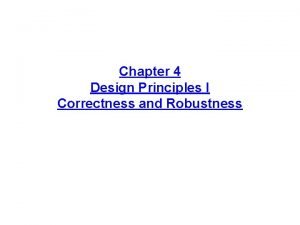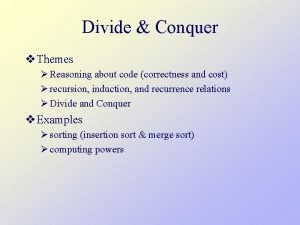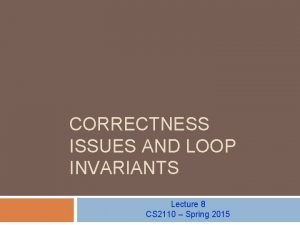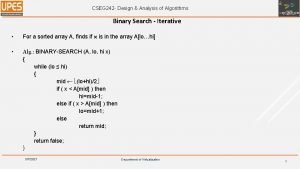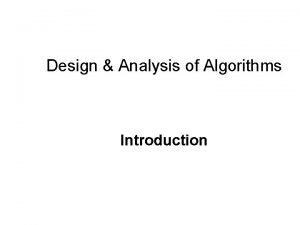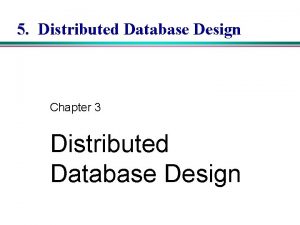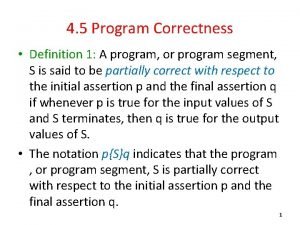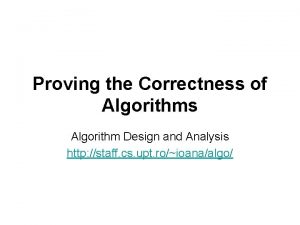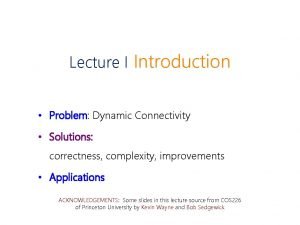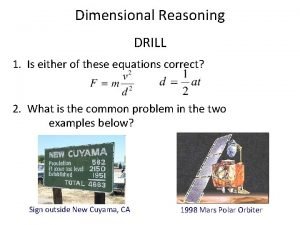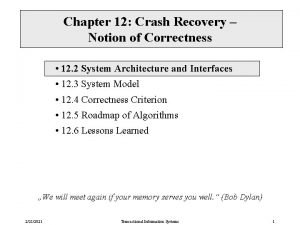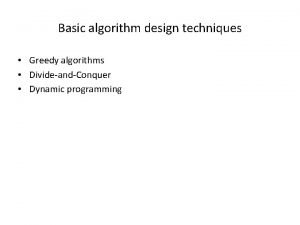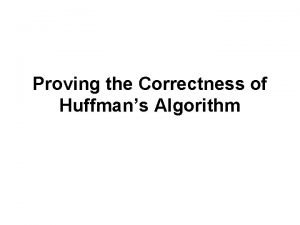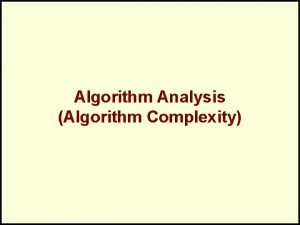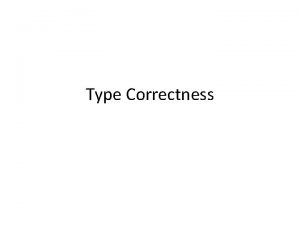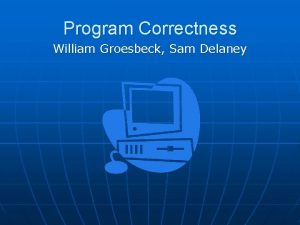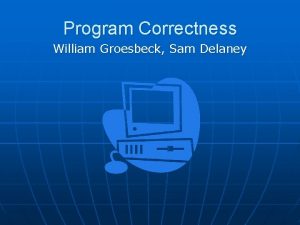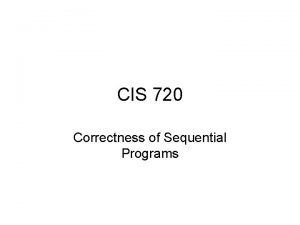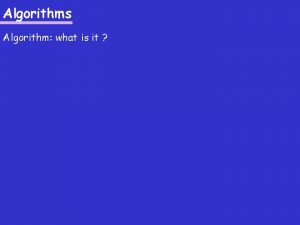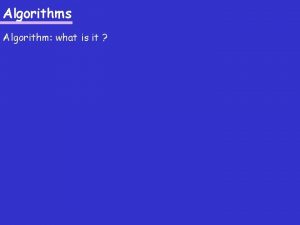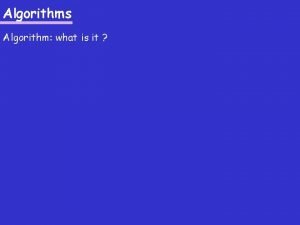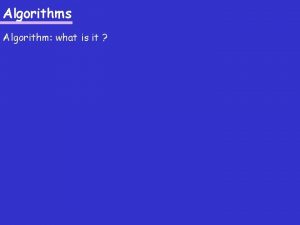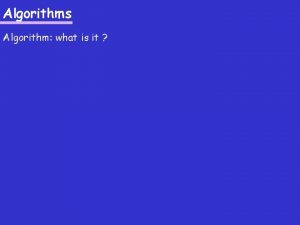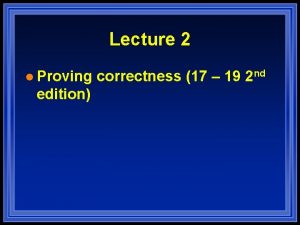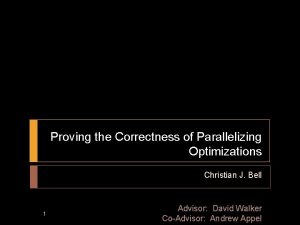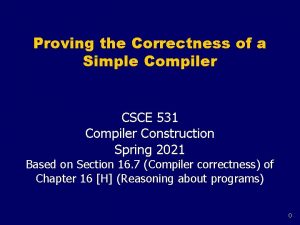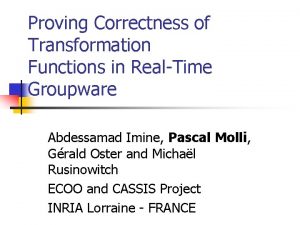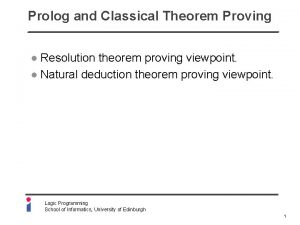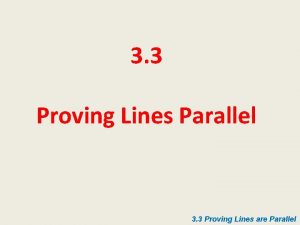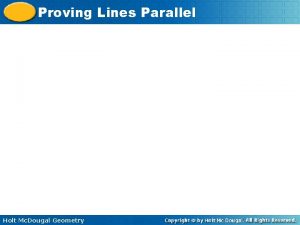Proving the Correctness of Algorithms Algorithm Design and


































![Bibliography • Proving correctness of algorithms, Induction: – [Manber] - chap 2 – [CLRS] Bibliography • Proving correctness of algorithms, Induction: – [Manber] - chap 2 – [CLRS]](https://slidetodoc.com/presentation_image_h/eceadcbd265ef858d0acf3acdec47653/image-35.jpg)
- Slides: 35

Proving the Correctness of Algorithms Algorithm Design and Analysis 2015 - Week 2 http: //bigfoot. cs. upt. ro/~ioana/algo/

Lecture Outline • Proving the Correctness of Algorithms – Preconditions and Postconditions – Loop Invariants – Induction – Math Review – Using Induction to Prove Algorithms

What does an algorithm ? • An algorithm is described by: – – Input data Output data Preconditions: specifies restrictions on input data Postconditions: specifies what is the result • Example: Binary Search – – Input data: a: array of integer; x: integer; Output data: found: boolean; Precondition: a is sorted in ascending order Postcondition: found is true if x is in a, and found is false otherwise

Correct algorithms • An algorithm is correct if: – for any correct input data: • it stops and • it produces correct output. – Correct input data: satisfies precondition – Correct output data: satisfies postcondition

Proving correctness • • An algorithm = a list of actions Proving that an algorithm is totally correct: 1. Proving that it will terminate 2. Proving that the list of actions applied to the precondition imply the postcondition – This is easy to prove for simple sequential algorithms – This can be complicated to prove for repetitive algorithms (containing loops or recursivity) • use techniques based on loop invariants and induction

Example – a sequential algorithm Swap 1(x, y): aux : = x x : = y y : = aux Precondition: x = a and y = b Postcondition: x = b and y = a Proof: the list of actions applied to the precondition imply the postcondition 1. Precondition: x = a and y = b 2. aux : = x => aux = a 3. x : = y => x = b 4. y : = aux => y = a 5. x = b and y = a is the Postcondition

Example – a repetitive algorithm Algorithm Sum_of_N_numbers Input: a, an array of N numbers Output: s, the sum of the N numbers in a s: =0; k: =0; While (k<N) do k: =k+1; s: =s+a[k]; end Proof: the list of actions applied to the precondition imply the postcondition BUT: we cannot enumerate all the actions in case of a repetitive algorithm ! We use techniques based on loop invariants and induction

Loop invariants • A loop invariant is a logical predicate such that: if it is satisfied before entering any single iteration of the loop then it is also satisfied after the iteration

Example: Loop invariant for Sum of n numbers Algorithm Sum_of_N_numbers Input: a, an array of N numbers Output: s, the sum of the N numbers in a s: =0; k: =0; While (k<N) do k: =k+1; s: =s+a[k]; end Loop invariant = induction hypothesis: At step k, S holds the sum of the first k numbers

Using loop invariants in proofs • We must show the following 3 things about a loop invariant: 1. Initialization: It is true prior to the first iteration of the loop. 2. Maintenance: If it is true before an iteration of the loop, it remains true before the next iteration. 3. Termination: When the loop terminates, the invariant gives us a useful property that helps show that the algorithm is correct.

Example: Proving the correctness of the Sum algorithm (1) • Induction hypothesis: S= sum of the first k numbers 1. Initialization: The hypothesis is true at the beginning of the loop: Before the first iteration: k=0, S=0. The first 0 numbers have sum zero (there are no numbers) => hypothesis true before entering the loop

Example: Proving the correctness of the Sum algorithm (2) • Induction hypothesis: S= sum of the first k numbers 2. Maintenance: If hypothesis is true before step k, then it will be true before step k+1 (immediately after step k is finished) We assume that it is true at beginning of step k: “S is the sum of the first k numbers” We have to prove that after executing step k, at the beginning of step k+1: “S is the sum of the first k+1 numbers” We calculate the value of S at the end of this step K: =k+1, s: =s+a[k+1] => s is the sum of the first k+1 numbers

Example: Proving the correctness of the Sum algorithm (3) • Induction hypothesis: S= sum of the first k numbers 3. Termination: When the loop terminates, the hypothesis implies the correctness of the algorithm The loop terminates when k=n=> s= sum of first k=n numbers => postcondition of algorithm, DONE

Loop invariants and induction • Proving loop invariants is similar to mathematical induction: – showing that the invariant holds before the first iteration corresponds to the base case, and – showing that the invariant holds from iteration to iteration corresponds to the inductive step.

Mathematical induction - Review • Let T be a theorem that we want to prove. T includes a natural parameter n. • Proving that T holds for all natural values of n is done by proving following two conditions: 1. T holds for n=1 2. For every n>1 if T holds for n-1, then T holds for n Terminology: T= Induction Hypothesis 1= Base case 2= Inductive step

Mathematical induction - review • Strong Induction: a variant of induction where the inductive step builds up on all the smaller values • Proving that T holds for all natural values of n is done by proving following two conditions: 1. T holds for n=1 2. For every n>1 if T holds for all k<= n-1, then T holds for n

Mathematical induction – Example 1 • Theorem: The sum of the first n natural numbers is n*(n+1)/2 • Proof: by induction on n 1. Base case: If n=1, s(1)=1=1*(1+1)/2 2. Inductive step: We assume that s(n)=n*(n+1)/2, and prove that this implies s(n+1)=(n+1)*(n+2)/2 , for all n>=1 s(n+1)=s(n)+(n+1)=n*(n+1)/2+(n+1)=(n+1)*(n+2)/2

Mathematical induction – Example 2 • Theorem: Every amount of postage that is at least 12 cents can be made from 4 -cent and 5 cent stamps. • Proof: by induction on the amount of postage • Postage (p) = m * 4 + n * 5 • Base case: – Postage(12) = 3 * 4 + 0 * 5 – Postage(13) = 2 * 4 + 1 * 5 – Postage(14) = 1 * 4 + 2 * 5 – Postage(15) = 0 * 4 + 3 * 5

Mathematical induction – Example 2 (cont) • Inductive step: We assume that we can construct postage for every value from 12 up to k. We need to show to construct k + 1 cents of postage. Since we have proved base cases up to 15 cents, we can assume that k + 1 ≥ 16. • Since k+1 ≥ 16, (k+1)− 4 ≥ 12. So by the inductive hypothesis, we can construct postage for (k + 1) − 4 cents: (k + 1) − 4 = m * 4+ n * 5 • But then k + 1 = (m + 1) * 4 + n * 5. So we can construct k + 1 cents of postage using (m+1) 4 -cent stamps and n 5 -cent stamps

Correctness of algorithms • Induction can be used for proving the correctness of repetitive algorithms: – Iterative algorithms: • Loop invariants – Induction hypothesis = loop invariant = relationships between the variables during loop execution – Recursive algorithms • Direct induction – Hypothesis = a recursive call itself ; often a case for applying strong induction

Example: Correctness proof for Decimal to Binary Conversion Algorithm Decimal_to_Binary Input: n, a positive integer Output: b, an array of bits, the bin repr. of n, starting with the least significant bits t: =n; k: =0; While (t>0) do k: =k+1; b[k]: =t mod 2; t: =t div 2; end It is a repetitive (iterative) algorithm, thus we use loop invariants and proof by induction

Example: Loop invariant for Decimal to Binary Conversion Algorithm Decimal_to_Binary Input: n, a positive integer Output: b, an array of bits, the bin repr. of n t: =n; k: =0; While (t>0) do k: =k+1; b[k]: =t mod 2; t: =t div 2; end At step k, b holds the k least significant bits of n, and the value of t, when shifted by k, corresponds to the rest of the bits 1 2 3 k 20 21 22 2 k-1 b

Example: Loop invariant for Decimal to Binary Conversion Algorithm Decimal_to_Binary Input: n, a positive integer Output: b, an array of bits, the bin repr. of n t: =n; k: =0; While (t>0) do k: =k+1; b[k]: =t mod 2; t: =t div 2; end Loop invariant: If m is the integer represented by array b[1. . k], then n=t*2 k+m 1 2 3 k 20 21 22 2 k-1 b

Example: Proving the correctness of the conversion algorithm • Induction hypothesis=Loop Invariant: If m is the integer represented by array b[1. . k], then n=t*2^k+m • To prove the correctness of the algorithm, we have to prove the 3 conditions: 1. Initialization: The hypothesis is true at the beginning of the loop 2. Maintenance: If hypothesis is true for step k, then it will be true for step k+1 3. Termination: When the loop terminates, the hypothesis implies the correctness of the algorithm

Example: Proving the correctness of the conversion algorithm (1) • Induction hypothesis: If m is the integer represented by array b[1. . k], then n=t*2^k+m 1. The hypothesis is true at the beginning of the loop: k=0, t=n, m=0(array is empty) n=n*2^0+0

Example: Proving the correctness of the conversion algorithm (2) • Induction hypothesis: If m is the integer represented by array b[1. . k], then n=t*2^k+m 2. If hypothesis is true for step k, then it will be true for step k+1 At the start of step k: assume that n=t*2^k+m, calculate the values at the end of this step If t=even then: t mod 2==0, m unchanged, t=t / 2, k=k+1=> (t / 2) * 2 ^ (k+1) + m = t*2^k+m=n If t=odd then: t mod 2 ==1, b[k+1] is set to 1, m=m+2^k , t=(t-1)/2, k=k+1 => (t-1)/2*2^(k+1)+m+2^k=t*2^k+m=n

Example: Proving the correctness of the conversion algorithm (3) • Induction hypothesis: If m is the integer represented by array b[1. . k], then n=t*2^k+m 3. When the loop terminates, the hypothesis implies the correctness of the algorithm The loop terminates when t=0 => n=0*2^k+m=m n==m, proved

Proof of Correctness for Recursive Algorithms • In order to prove recursive algorithms, we have to: 1. Prove the partial correctness (the fact that the program behaves correctly) • we assume that all recursive calls with arguments that satisfy the preconditions behave as described by the specification, and use it to show that the algorithm behaves as specified 2. Prove that the program terminates • any chain of recursive calls eventually ends and all loops, if any, terminate after some finite number of iterations.

Example - Merge Sort MERGE-SORT(A, p, r) if p < r q= (p+r)/2 MERGE-SORT(A, p, q) MERGE-SORT(A, q+1, r) MERGE(A, p, q, r) p q Precondition: Array A has at least 1 element between indexes p and r (p<=r) Postcondition: The elements between indexes p and r are sorted r

Example - Merge Sort • MERGE-SORT calls a function MERGE(A, p, q, r) to merge the sorted subarrays of A into a single sorted one • The proof of MERGE (which is an iterative function) can be done separately, using loop invariants • We assume here that MERGE has been proved to fulfill its postconditions (can do it as a distinct exercise) MERGE (A, p, q, r) Precondition: A is an array and p, q, and r are indices into the array such that p <= q < r. The subarrays A[p. . q] and A[q +1. . r] are sorted Postcondition: The subarray A[p. . r] is sorted

Correctness proof for Merge-Sort • Number of elements to be sorted: n=r-p+1 • Base Case: n = 1 – A contains a single element (which is trivially “sorted”) • Inductive Hypothesis: – Assume that Merge. Sort correctly sorts n=1, 2, . . . , k elements • Inductive Step: – Show that Merge. Sort correctly sorts n = k + 1 elements. – First recursive call n 1=q-p+1=(k+1)/2<=k => subarray A[p. . q] is sorted – Second recursive call n 2=r-q=(k+1)/2<=k => subarray A[q+1. . r] is sorted – A, p q, r fulfill now the precondition of Merge – The postcondition of Merge guarantees that the array A[p. . r] is sorted => postconsition of Merge. Sort

Correctness proof for Merge-Sort • Termination: – To argue termination, we have to find a quantity that decreases with every recursive call: the length of the part of A considered by a call to Merge. Sort – For the base case, we have a one-element array. the algorithm terminates in this case without making additional recursive calls.

Correctness proofs for recursive algorithms RECURSIVE(n) is if (n=small_value) return ct else RECURSIVE(n 1) … RECURSIVE(nr) some_code n 1, n 2, … nr are some values smaller than n but bigger than small_value • Base Case: Prove that RECURSIVE works for n = small_value • Inductive Hypothesis: – Assume that RECURSIVE works correctly for n=small_value, . . . , k • Inductive Step: – Show that RECURSIVE works correctly for n = k + 1

Lecture Summary • Proving that an algorithm is totally correct means: 1. Proving that it will terminate 2. Proving that the list of actions applied to the precondition imply the postcondition • How to prove repetitive algorithms: – Iterative algorithms: use Loop invariants, Induction – Recursive algorithms: use induction using as hypothesis the recursive call
![Bibliography Proving correctness of algorithms Induction Manber chap 2 CLRS Bibliography • Proving correctness of algorithms, Induction: – [Manber] - chap 2 – [CLRS]](https://slidetodoc.com/presentation_image_h/eceadcbd265ef858d0acf3acdec47653/image-35.jpg)
Bibliography • Proving correctness of algorithms, Induction: – [Manber] - chap 2 – [CLRS] – chap 2. 1, chap 2. 3. 1 • Course website (Slides, Labs) – http: //bigfoot. cs. upt. ro/~ioana/algo/
 Loop invariant proof examples
Loop invariant proof examples Principles of correctness
Principles of correctness Divide and conquer
Divide and conquer Loop invarient
Loop invarient 1001 design
1001 design Design and analysis of algorithms introduction
Design and analysis of algorithms introduction Binary search in design and analysis of algorithms
Binary search in design and analysis of algorithms Introduction to the design and analysis of algorithms
Introduction to the design and analysis of algorithms Design and analysis of algorithms
Design and analysis of algorithms Design and analysis of algorithms
Design and analysis of algorithms Comp 482
Comp 482 Entity integrity ensures correctness of the data in a table
Entity integrity ensures correctness of the data in a table Examples of consideration in communication
Examples of consideration in communication What are the principles of business communication
What are the principles of business communication Bfs proof of correctness
Bfs proof of correctness Courtesy clarity conciseness concreteness completeness
Courtesy clarity conciseness concreteness completeness Implies “stepping into the shoes of others”.
Implies “stepping into the shoes of others”. Com_min algorithm
Com_min algorithm Reliability vs correctness
Reliability vs correctness Emotional correctness
Emotional correctness Loop invariant of bubble sort
Loop invariant of bubble sort Sweety gupta
Sweety gupta What is program correctness
What is program correctness Proof of correctness examples
Proof of correctness examples Correctness of fragmentation
Correctness of fragmentation Dynamic connectivity problem
Dynamic connectivity problem Principles of distributed database systems
Principles of distributed database systemsFunctional correctness
 Dimensional homogeneity
Dimensional homogeneity Crash recovery definition
Crash recovery definition Algorithm design techniques
Algorithm design techniques Algorithms for visual design
Algorithms for visual design Algorithms for visual design
Algorithms for visual design Ao * algorithm
Ao * algorithm Prof. slim codeforces
Prof. slim codeforces Hình ảnh bộ gõ cơ thể búng tay
Hình ảnh bộ gõ cơ thể búng tay

